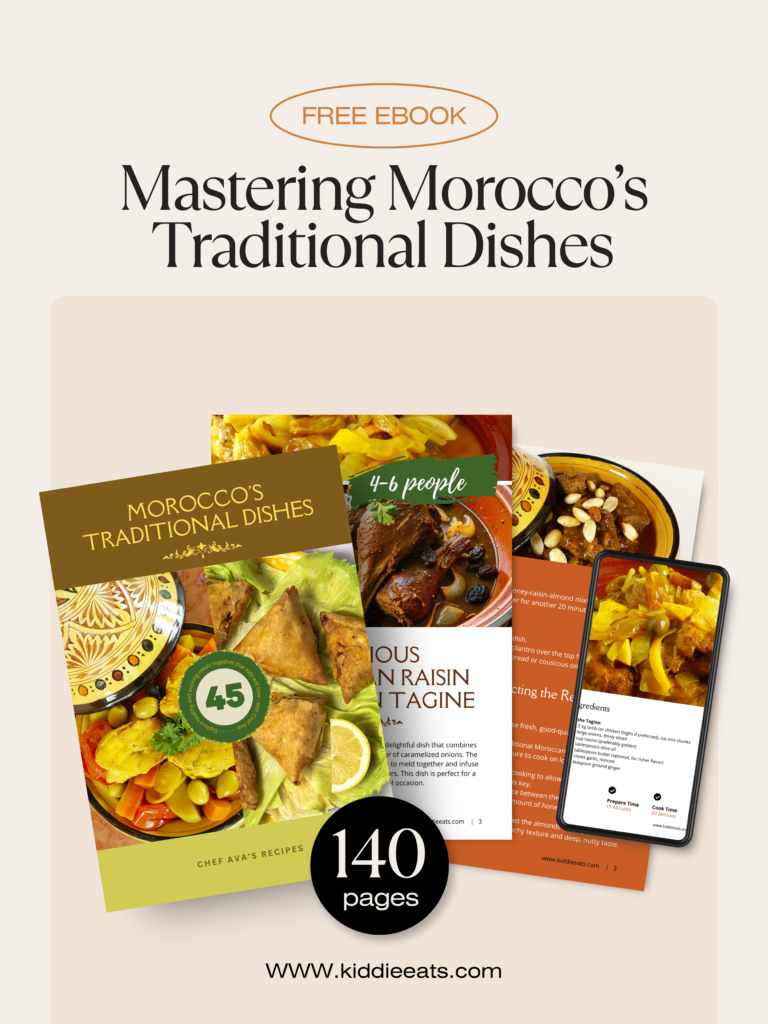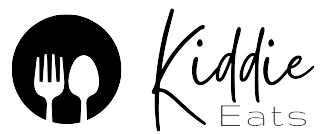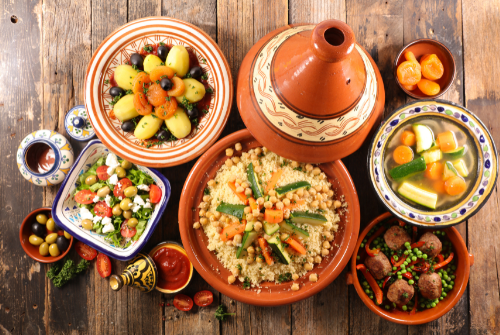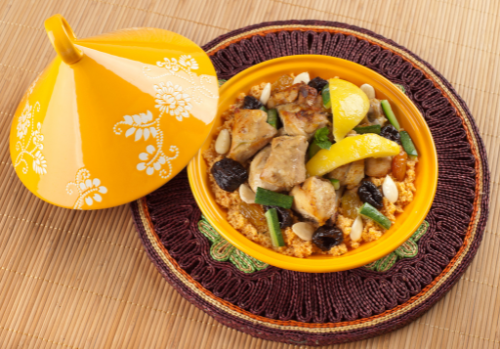
Food in Morocco(1) is a vibrant reflection of the country's rich history, cultural fusion, and geographical diversity. From bustling souks to family kitchens, Moroccan cuisine captivates the senses with its bold flavors, aromatic spices, and centuries-old traditions. Food in Morocco is rooted in Berber, Arab, Andalusian, and Mediterranean influences, creating dishes that are both unique and universally loved.
(N.B: Get ready to explore these mouthwatering recipes—download our exciting eBook at the bottom of the page to dive in! )
Whether you’re savoring a steaming tagine, indulging in a plate of couscous, or dipping into harira during Ramadan, the experience is unforgettable(2). Food in Morocco is more than just sustenance; it’s a way of life, often enjoyed communally, and celebrated with joy and hospitality. For travelers and food lovers alike, exploring the culinary landscape of Morocco is an adventure of flavors and textures.
FAQs about Traditional Food in Morocco
- What are the most famous dishes in Morocco?
- What is the staple food in Morocco?
- Is Moroccan food spicy?
- What is a Moroccan tagine?
- What should I eat in Morocco?
- What is a common Moroccan breakfast?
- Are there vegetarian options in Moroccan cuisine?
- What is Moroccan mint tea?
- What is a traditional Moroccan dessert?
- How can I cook Moroccan dishes at home?
You’ll find initial answers to these questions throughout the paragraphs of this article. You’ll also find engaging insights in our free e-book, crafted with love for the deep-rooted culture of Morocco and its people.
The Diversity of Moroccan Cuisine
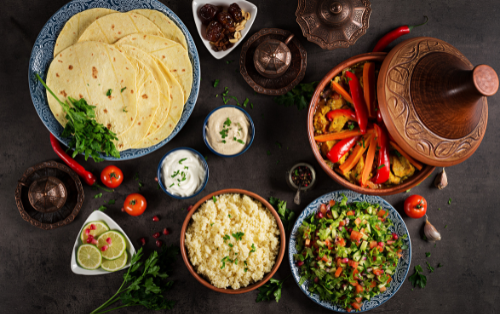
Moroccan cuisine offers something for every palate. Staples such as couscous and tagine are essential to any Moroccan meal. These dishes reflect the influence of Berber cooking, but Moroccan cuisine is also shaped by Arab and Mediterranean flavors. Spices like saffron, cumin, and cinnamon are widely used to create the rich, layered flavors that are characteristic of food in Morocco.
Traditional Food in Morocco
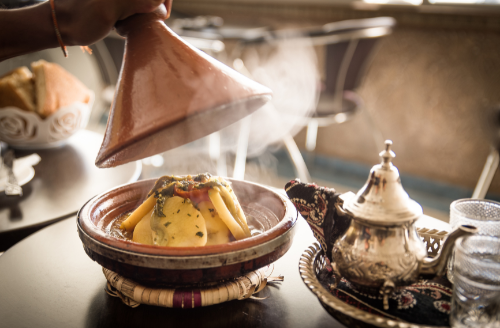
Traditional food in Morocco includes a wide variety of both sweet and savory dishes. Harira, a lentil and tomato-based soup, is often served during Ramadan, while msmen, a flaky bread, is a common breakfast item. For the adventurous, Moroccan street food offers delights such as pastilla (a savory-sweet pie) and ma’akouda (potato fritters).
Cultural Significance of Moroccan Food
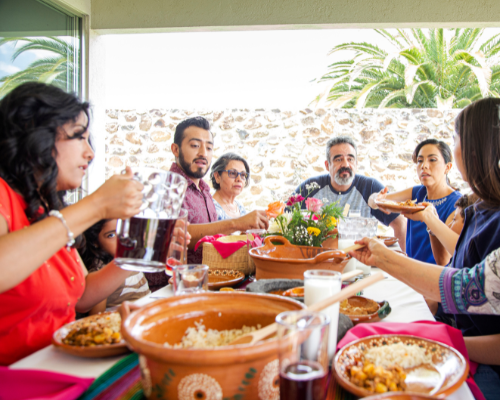
Food in Morocco is closely tied to social and family gatherings. Meals are a communal experience, often shared from a large dish. The hospitality of the Moroccan people is evident in their food customs, where guests are treated with an abundance of dishes, each more flavorful than the last. Food plays a central role in religious and cultural celebrations as well, from wedding feasts to Ramadan iftar meals.
Iconic Moroccan Dishes
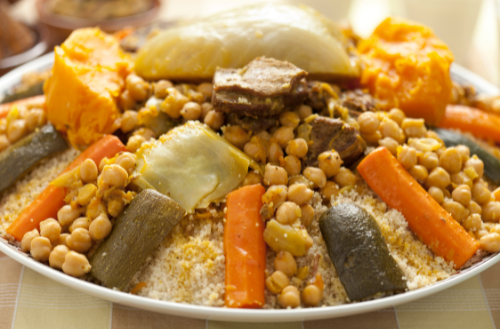
Among the best foods to eat in Morocco, tagine and couscous stand out. These are often accompanied by side dishes such as zaalouk (a smoky eggplant dip) and chermoula (a marinade for fish or vegetables). Desserts are just as diverse, with options like chebakia (sesame-coated fried pastries) and sfenj (Moroccan donuts). Moroccan mint tea, sweetened with plenty of sugar, is a staple beverage that accompanies most meals.
Cooking Moroccan Dishes at Home
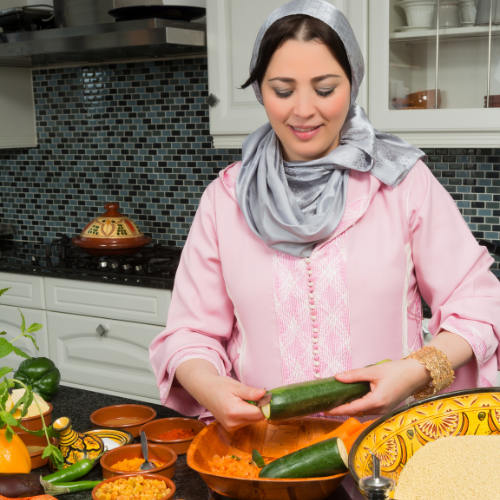
Many people worldwide have come to appreciate Moroccan cuisine and want to recreate these dishes at home. To cook authentic Moroccan food, it’s essential to use traditional ingredients like preserved lemons, olives, and an array of aromatic spices such as ras el hanout, a signature Moroccan spice mix. Whether it’s perfecting the art of the tagine or mastering homemade couscous, Moroccan cuisine brings a sense of adventure into the kitchen.
Presentation of Moroccan Dishes
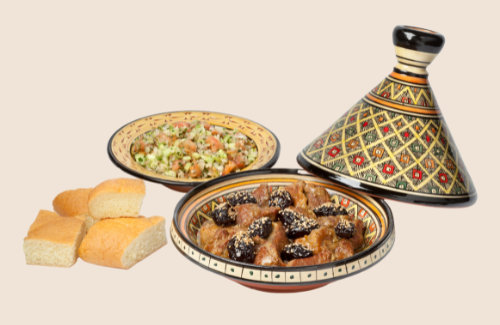
In Morocco, the presentation of food is as important as the flavor. Dishes are often served in beautifully crafted tagines, and large platters are used for communal meals. Fresh herbs like cilantro and parsley add both color and flavor, while olives, lemon slices, and dried fruits are often used to garnish.
Moroccan Cuisine on the Global Stage
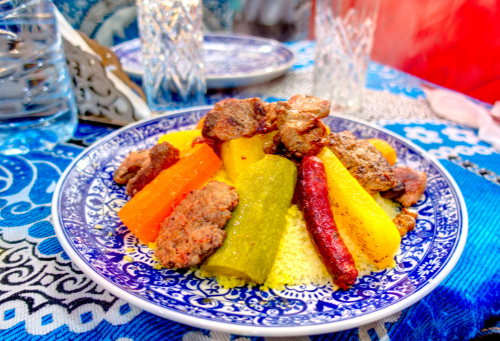
Moroccan cuisine has earned an honorable rank among the best international cuisines(3). Its unique blend of flavors and culinary traditions has made it one of the most admired in the world. From the souks of Marrakech to Michelin-starred restaurants abroad, Moroccan dishes continue to enchant food lovers globally.
Moroccan pantry essentials

Here’s a list of Moroccan pantry essentials that are commonly used in Moroccan cooking.
Spices:
- Ras el Hanout(4): A signature spice blend that includes various spices such as cumin, coriander, cinnamon, and more.
- Cumin: Essential for flavoring many Moroccan dishes.
- Paprika: Often used for color and a mild pepper flavor.
- Turmeric: Adds color and a warm flavor to dishes.
- Cinnamon: Commonly used in both savory and sweet dishes.
Legumes:
- Chickpeas: Used in tagines and stews.
- Lentils: Often found in soups like harira.
Grains:
- Couscous: A staple grain that accompanies many meals.
- Rice: Frequently used in various dishes.
Preserved Ingredients:
- Preserved Lemons: A key ingredient that adds a unique flavor to dishes.
- Olives: Often served as appetizers or used in salads and tagines.
Herbs:
- Cilantro: Used fresh in salads and as a garnish.
- Parsley: Also used fresh for flavoring dishes.
Fats:
- Olive Oil: The primary cooking fat in Moroccan cuisine.
- Butter: Often used in pastries and some savory dishes.
Vegetables:
- Tomatoes: Used in various sauces and stews.
- Onions: Essential for flavoring and base for many dishes.
Nuts and Dried Fruits:
- Almonds: Used in both savory and sweet dishes.
- Raisins: Often added to tagines for sweetness.
Teas:
Green Tea: Especially mint tea, which is a cultural staple.
Breads:
Khobz: Traditional Moroccan bread that accompanies most meals.
- Morocco’s unique geographical position, nestled between Europe and Africa, has shaped its cultural diversity and rich culinary traditions. The Moroccan cuisine, blending Berber, Arab, Mediterranean, and Andalusian influences, stands out globally for its vibrant flavors and aromatic spices. Its world-renowned dishes, such as tagine and couscous, have earned it a prestigious place in global gastronomy, making Morocco a top destination for food lovers seeking an authentic and flavorful culinary experience. ↩︎
- To inspire children’s culinary adventures, consider incorporating elements of Moroccan cuisine into fun and creative meals. For example, you can create colorful couscous salads with fresh vegetables or prepare flavorful tagines using chicken and apricots. Engaging kids in cooking activities that showcase different cultures can make meals exciting and educational. ↩︎
- In 2014, Moroccan cuisine was recognized as the 2nd best gastronomy in the world by WorldSIM Travel Blog, highlighting its rich cultural fusion and flavorful dishes.
in 2024, Chef Gordon Ramsay announced that Moroccan cuisine was voted the best in the world by Instagram users, earning over 2.5 million votes from food enthusiasts globally. ↩︎ - C.F recipe in the e-book ↩︎
You might also like:
- Exploring Global Cuisines: 40 Must-Try World Flavors
- Global Flavors for Little Palates
- The Importance of Balanced Diets for Young Children
- Creative ways to hide veggies in meals
- Flavor Enhancers in Food: Top 10 Additives and Their Benefits
- Pantry Staples: The Essential Guide to DIY Kitchen Essentials
- 10 Strategies to Encourage Kids to Try New Foods
